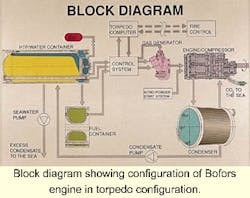Thermal propulsion could transform AUV travel capability
Autonomous underwater vehicles (AUVs) offer significant potential to the offshore industry, particularly for survey tasks due to their "launch and forget" capabilities. Unlike remotely operated vehicles (ROV), they do not require large winches and umbilical cable handling drums, AUV operators have a wider choice of vessels of opportunity and they are also able to operate in sea conditions that would make ROV use impractical. Their principal limitation is the life of their batteries. However, Bofors Underwater Systems believes this can be overcome through use of its latest torpedo propulsion system.
Bofors Underwater Systems, which is part of the Celsius group, has considerable experience in the practicalities of using small subsea vehicles. Its Sea Owl observation class ROV is depth rated to 500 meters and offers a number of unique characteristics. These include an exceptional level of maneuverability that gives it six degrees of freedom. This is combined with outstanding stability in any attitude which is invaluable for gaining video images or for undertaking survey or light work tasks.
As a supplier to the world's defense industries, Bofors also has experience in the design and manufacture of sophisticated homing torpedoes. Its latest weapon is powered by a thermal propulsion engine that is claimed to offer three times the endurance of batteries, and the company believes this technique could be transferred to AUVs.
The engine is powered by hydrogen peroxide that supplies the oxygen used to burn kerosene in the engine's combustion process. This is a unique piston engine that has been designed to be as silent as an electric motor, which is considered a potential benefit if the AUV is operating with acoustic sensors.
The propulsion unit is an axial piston steam engine with seven cylinders which act against a sinusoidal double cam. This keeps it in dynamic balance, reducing vibration and it has a direct drive that requires no reduction gear. The engine's pistons are linked to the pistons of the compressor and a condenser is built around the entire unit that would be mounted on vibration absorbers in the AUV's hull. The engine is powered by HTP (high test peroxide) which reacts with kerosene fuel in the steam generator. The temperature of the reaction products is reduced by fresh water to a level suitable for the engine. The exhausts from the engine, mainly steam and carbon dioxide pass through the condenser and most of the condensate is recycled back into the process. The carbon dioxide is pumped out where it dissolves into the surrounding seawater.
Since the engine has been designed for use in torpedoes, it is highly robust and reliable, being capable of dependable starting and sustained very high speeds if required. When used in an AUV at survey speeds, it should be capable of significantly longer endurance than batteries. Because its working life is considerably longer than that of a battery pack, the cost of the engine is expected to be significantly lower.
Refueling the engine could be quickly performed at sea by refilling the kerosene tank directly and by substituting a new HPT container. As the engine is not significantly affected by ambient pressure, Bofors Underwater Systems also believes that it could have numerous deepwater applications. One might be to serve as a seabed generator that could be used to power remote installations or to recharge the batteries of electrically powered vehicles.
For more information contact Magnus Karlsson, Bofors Underwater Systems, Tel: +46 141 22 45 18, Fax: +46 141 22 45 54.
